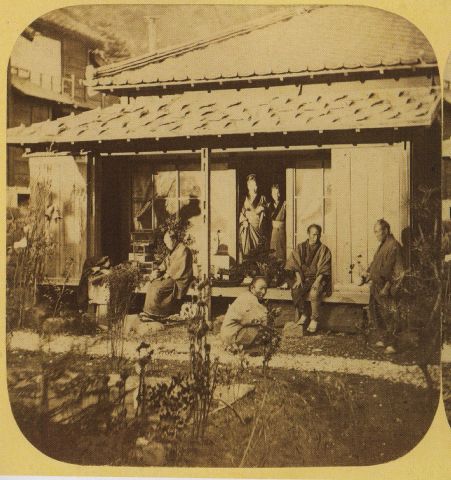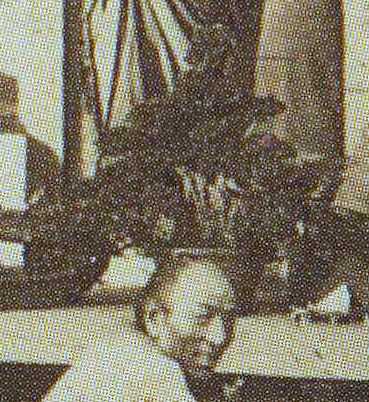


Detail of just right of center, in front of the building's door.
|
Currently, the oldest-known
photograph from Japan which includes a dwarf potted tree was published in 1861,
"Jeda. Group of Japanese, and General Construction of a Japanese Dwelling" by Pierre Joseph
Rossier. Rossier's identity has been a bit of a mystery until recently, but the following
information has been assembled. He was born into a farming family in the canton of Freiburg,
Switzerland in 1829. At age 16 he was given a teaching post at a nearby school.
A decade later he received a three-year passport listing his occupation as "photographer."
Now, Negretti and Zambra was a very successful London operation which specialized in the manufacture and sale of photographic and scientific equipment. The firm, which also managed its own photo studios, received a considerable boost when it was appointed as official photographer to the Crystal Palace Company. Negretti and Zambra was also a large retailer of stereoscopic views, issuing a significant number of collections from the early 1850s onward. Rossier apparently joined the staff after he left Switzerland in 1855. The firm took on the heavy expense and uncertainty of sending Rossier to China to photograph the Second Opium War of 1857-60. Details of his time in Asia are sketchy. He arrived in Hong Kong on July 7, 1858. (A set of fifty views, mostly from from the Canton area, were published in late 1859.) In the month between late May and June, 1859, Rossier travelled from Hong Kong to Shanghai, to the Philippines, back to Hong Kong, on to Nagasaki and then to Edo. He was in Japan possibly three different times. Whilst in Nagasaki for a few weeks in 1860, he taught wet-plate photography to several Japanese who went on to become notable native photographers. Rossier's negatives were shipped back to London on various occasions and at least one set may have been damaged during the typical ten to twelve week voyages. He himself returned to Switzerland sometime in 1862, having finished a set of views in Siam and possibly India, as well. Rossier married in October 1865, his first son was born the following summer, but his young wife died the next spring. He spent a year in France in 1872 and his photo studio in Freiburg, Switzerland was in operation until at least 1876. He married a second time and a second son was born in early 1884. Rossier died in Paris sometime between 1883 and 1898. Rossier's views in China and Japan represent the first commercially published photographs taken in those countries. For this reason alone, Pierre Rossier's place in Far Eastern photo-history is assured. The bonsai in this photograph appears to be a multi-trunked conifer over a foot-and-a-half in height with a two-foot-wide spread in a deep bowl pot. It seems to be a very good specimen, not something kept by an otherwise-disinterested family for mere show. While the human figures in the stereoscopic pair do show varying degrees of depth, the tree doesn't. 1 |
|
1
Bennett, Terry
Photography in Japan, 1853-1912
; (Tokyo and Rutland, VT: Tuttle Publishing; 2006), biographical data pp. 41-49, photo
on pg. 51, Fig. 49, left-hand image captioned as 'Pierre Rossier, "Jeda. Group of
Japanese, and General Construction of a Japanese Dwelling," No. 61, from Negretti
and Zambra's Views in Japan, first series, albumen-print stereoview, published
1861. Author's Collection.' |